|
|
|
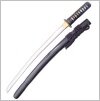 |
|
| Hanwei Miyamoto Musashi Wakizashi (SH1017) |
Points: 20
|
During the Muromachi period (1568-1603), the introduction of the pairing of the Katana (the curved sword) and Wakizashi was introduced. The Wakizashi, or the shorter companion blade to the Katana, was about 18 inches long. Only the warrior class - the Samurai - was allowed to wear the two swords, which remained a custom for the next several hundred years until abolished in the 19th century. This Wakizashi is the companion piece to the Musashi Miyamoto Katana (SH1016) with matching fittings and blade construction. Supplied with a protective cloth bag and traditional maintenance kit.
Hand forged high-carbon steel
Built for cutting
Traditional construction
Sold Out
|
|
|
|
|
|
 |
|
| Hanwei Great Wave - Tsunami Wakizashi (SH5002) |
Points: 30

|
Each piece in the Great wave Series (SH5004, SH5002, & SH5022) is stylized with the renowned Tomoe motif. The tsuba, fuchi, & kashira are made of black iron and marked with the Tomoe crest (mon). The blades are hand-forged from T10 high-carbon steel and are differentially tempered using traditional claying methods. The temper line (hamon) is evident and prominent. Each piece has a deeply lacquered black saya with a one-piece brass habaki construction. Real ray skin (same) is used on the tsuka, and the tsuka-ito and sageo are made of premium woven Japanese black cotton. The katana and wakizashi are constructed with a large o-kissaki and are ideal for cutting exercises (tameshigiri). The handle on the tanto is an attractive ribbed buffalo horn.
High-carbon steel
Deeply lacquered black saya
Ideal for cutting exercises
Sold Out
|
|
|
|
|
|
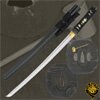 |
|
| Hanwei Tea Culture Wakizashi (SH2332) |
Points: 25


|
In Japan the traditional method of serving tea is a celebrated art form in itself. This highly ritualized ceremony is an involved process, the most elaborate of which can last hours and is reserved for the most distinguished of guests. Our Tea Culture Daisho (SH2331, SH2332) captures the essence of this important tradition. The Katana and Wakizashi are built upon a traditional Shinogi Zukuri style blade with Bo-Hi. The high-carbon blade is hand forged and differentially hardened using the traditional clay method. The Koshirae (furniture) feature the typical elements present in a Japanese tea ceremony. The handle is wrapped with suede leather in a Katati Make (battle wrap) style.
Sold Out
|
|
|
|
|
|
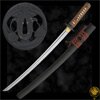 |
|
| Hanwei Three Monkey Wakizashi (SH2330) |
Points: 40

|
The "Three Wise Monkeys" is a popular symbol of the "See no evil, hear no evil, speak no evil" proverb popular in many cultures around the world. The proverb itself is thought to have originated in China and was brought to Japan by a Buddhist monk, while the association with three monkeys appears to be a Japanese play on words. Our Three Monkey Katana (SH2329) and Wakizashi (SH2330) are built on traditional Shinogi Zukuri style blades with Bo-Hi to reduce weight and improve balance. The high-carbon blade is hand forged and differentially hardened. The blackened iron Tsuba features the "Three Wise Monkeys" in relief.
Sold Out
|
|
|
|
|
|
 |
|
| Hanwei Bushido Wakizashi (SH1211) |
Points: 30

|
Each piece in the Bushido Series (SH1210, SH1211, & SH1212) has a hand-forged & folded K120C powder steel blade, differentially tempered using a traditional claying method to produce an HRC60 edge, HRC40 back. The temper line (hamon) is evident and prominent and the grain pattern (hada) shows distinct layers. The saya are deeply lacquered in gold with inlaid brass cherry blossom (sakura) flowers. High quality ray skin (same) is used on the tsuka of the katana and wakizashi, while the tsuka of the tanto is a gold-plated brass with a battle-scene decoration in relief. The tsuba of the katana and wakizashi is of blackened and bronzed iron, with detailing in gold and silver and a battle scene decoration. The tsuka-ito on the katana and wakizashi and the sageo on all three pieces are woven from premium Japanese cotton. The fuchi and kashira are of blackened bronze with brass detailing, and the kojiri, koiguchi and kurikata are of polished buffalo horn. The blade collar (habaki) is a one-piece brass construction. The katana and wakizashi blades are un-grooved, while the tanto blade is grooved (bo-hi) on both sides. The katana and wakizashi have medium-length (chu) kissaki. See Models SH1210 and SH1212 for the Katana and Tanto details.
Hand forged and folded steel blade
High quality
Traditional construction
Sold Out
|
|
|
|
|
|
 |
|
| Hanwei Tiger Wakizashi (SH1205) |
Points: 35
|
Each piece in the Tiger group has a hand-forged and folded ASSAB-K120C powder steel blade, differentially tempered to produce an HRC60 edge, HRC40 back and a distinctive hamon. Saya are deeply lacquered in black, with inlaid brass bamboo leaves. The ray skin used on the tsuka is of the highest quality, and the tsuka-ito and sageo on all three pieces are woven from best quality Japanese cotton. The Fuchi, Kashira, Kojiri, Koiguchi and Kurigata are all made from blackened bronzed iron, selectively detailed in gold. The Tsuba of the Katana and Wakizashi are made from blackened iron, with a tiger inlaid in brass. The Habaki is of one-piece brass construction. The blades of all three pieces are grooved on both sides, with a short Kissaki on the Katana and Wakizashi. See Models SH1204 and SH1206 for the Katana and Tanto details.
Hand forged and folded steel blades
Excellent quality
Traditional construction
Sold Out
|
|
|
|
|
|
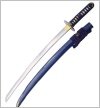 |
|
| Hanwei Orchid Wakizashi (SH1208) |
Points: 39
|
Each piece in the Orchid Series (SH1207, SH1208, & SH1209) has a hand-forged & folded K120C powder steel blade, differentially tempered using a traditional claying method to produce an HRC60 edge, HRC40 back. The temper line (hamon) is evident and prominent and the grain pattern (hada) shows distinct layers. The saya are deeply lacquered in blue. High quality ray skin (same) is used on the tsuka, and the tsuka-ito and sageo on all three pieces are woven from premium Japanese cotton. The tsuba of the katana and wakizashi is of blackened iron, with an Orchid and Butterfly decoration inlaid in silver, brass and copper. The scabbard mouth (koiguchi) and cord knob (kurikata) are of buffalo horn, and the fuchi, kashira and kojiri are of bronzed iron with silver and gold detailing. The blade collar (habaki) is a one-piece brass construction. The katana and wakizashi feature a medium-length (chu) kissaki. See Models SH1207 and SH1209 for the Katana and Tanto details.
Hand forged and folded steel blade
Excellent quality
Traditional construction
Sold Out
|
|
|
|
|
|
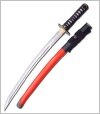 |
|
| Hanwei Kami Wakizashi (SH1202) |
Points: 50
|
Each piece in the Kami group has a hand-forged and folded ASSAB-K120C powder steel blade, differentially tempered to produce an HRC60 edge, HRC40 back and a distinctive hamon. Saya are deeply lacquered in red, with a black ring-carved section at the sageo. The ray skin used on the tsuka is of the highest quality, and the tsuka-ito on the Katana and Wakizashi and the sageo on all three pieces are woven from best quality Japanese silk. The Fuchi, Kashira, Kojiri, Koiguchi and Kurigata are all made from blackened bronze, with decoration in relief and selective detailing of copper, silver and gold. The Tsuba of the Katana and Wakizashi, depicting the Kami, or Guardian Warriors, are made from hardened blackened copper, with decoration in relief and selective silver and gold detailing. The Habaki is of two-piece construction, the inner section being copper and the outer section gold-plated brass. The blades are engraved, at the Habaki, with a hand-engraved "Fudo" horomono, a traditional blade carving from the Edo period. The blades of all three pieces are grooved on both sides, and each piece features a long Kissaki. See Models SH1201 and SH1203 for the Katana and Tanto details.
Hand forged and folded steel blades
Top-of-the-Line quality
Traditional construction
Sold Out
|
|
|
|
|
|
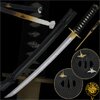 |
|
| Hanwei Paper Crane Wakizashi - Tamahagane (SH2328) |
Points: 60

|
Our Paper Crane Daisho (SH2294-Katana / SH2328-Wakizashi) is without doubt the greatest achievement in sword making artistry yet available from Hanwei. The blade is crafted from Hanwei's own Tamahagane steel (see below) while the fittings reflect the atmosphere of the Japanese theater. The Daisho's name stems from the origami (the art of paper folding) cranes that decorate the striking Tsuba and Fuchi/Kashira, all of which feature highly-prized "Nanako" or stippled backgrounds. The Menuki feature thespian masks, a symbol shared by the Japanese theater and its western counterpart. The Saya of the katana houses a Kozuka (small knife) while that of the Wakizashi carries a Kogai (hair pick) The Kozuka and Kogai are decorated with musical instruments of the theater. The Paper Crane theme is carried to the outstanding hand woven silk Sageo, the result of many hours of skilled work on a hand loom.
Sold Out
|
|
|
|
|
|
 |
|
| Hanwei Bamboo Mat Wakizashi (SH2448) |
Points: 20

|
Our Bamboo Mat Wakizashi features a chu-kissaki blade of Hanwei's own high-alloy HWS-2S steel, which combines impressive performance with a striking O-choji hamon. This steel is made in Hanwei's new factory, with high-tech equipment, producing a very pure, advanced-metallurgy blade with excellent edge-holding capability and resilience.
The fittings feature a bamboo-themed black iron tsuba, textured in a bamboo mat design with a jointed bamboo rim and highlighted with gold-tipped bamboo leaves. The fuchi/kashira follow the same theme and the golden menuki feature a pair of sparrows. The saya is finished in high-gloss lacquer with horn fittings.
Sold Out
|
|
|
|
|
|
 |
|
| Hanwei Lion Dog Wakizashi (SH2449) |
Points: 25

|
The Lion Dog Wakizashi features an O-Kissaki blade of Hanwei's own high-alloy HWS-1S steel, which combines superior performance with an outstanding O-choji hamon. This steel is made in Hanwei's new factory, with high-tech equipment, producing a very pure advanced-metallurgy blade with the best edge-holding capability and resilience of any blade ever produced by Hanwei. The outstanding performance characteristics of blades forged from HWS-1S steel derive from a combination of the careful selection of alloying elements and a complex processing procedure, basically involving the manipulation of the steel’s carbon content across the blade section. This results in a very tough and resilient blade with a hard, highly abrasion-resistant edge
Sold Out
|
|
|
|
|
|
 |
|
| Sword Cold Steel Seagal Signature Wakizashi Sword (88PKW) |
Points: 15
|
Martial Artist who needs no introduction. He found international acclaim for his high-octane Action Movies, but his first and foremost love is the world of Martial Arts. With an encyclopedic knowledge of the Japanese warrior arts, a wealth of experience with the Katana, a 7th Dan Black Belt in the art of Aikido and a lifetime of training, he is still a much-in-demand instructor and consultant. Whether working specialist techniques with Mixed Martial Artists or traveling the world teaching seminars, there is no doubt that Steven is still a force to be reckoned with
Sold Out
|
|
|
|
|
|
 |
|
| Cold Steel Sword - Imperial Wakizashi (88W) |
Points: 26

|
Handle: Samé (Ray Skin), black braid cord
Steel: 1055 High Carbon
Sheath: Black Lacquered Wood Scabbard
The Tsuba (guard), Fuchi (collar), and Kashira (pommel), are expertly made and finely crafted from black iron. The Habaki (blade collar), is hand made out of polished brass and each hilt is covered in Samé (ray skin) and tightly wrapped in the traditional style with black cord. A beautiful brass Menuki ( a small, ornamental sculpture inserted between the ray skin and the cord wrappings on the handle) enhances the sword's aesthetic appearance and makes for a sword that is as traditional looking as we can possibly make it.
Sold Out
|
|
|
|
|
|
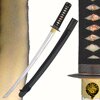 |
|
| Hanwei Nami Iaito Wakizashi (SH5019) |
Points: 17

|
Iaito have long been the preferred training tools for safe practice of the many Japanese sword drawing arts typically known as Iaido. While not designed for sword-on-sword contact or actual test cutting, the un-edged iaito is perfectly weighted and balanced for its designed task of safe, repetitive drawing practice.
The Nami, Gorin, and Tsuru iaito are a breakthrough in design and functionality. Made of a special stainless steel, the blades are much more durable than iaito blades made from aluminum alloy, with a "live" feel and much superior rigidity. Through a special tempering process, these Iaito blades eliminate the brittle behaviour sometimes associated with stainless steel, while retaining its low maintenance and rust-resistant qualities. These very affordable Iaito are the ideal training tools for safely praciticing this ancient art.
White Same w/ Black Cotton Ito & Sageo
Etched Wave Tsuba, Fuchi & Kashira
Copper Menuki, Habaki, Seppa & Shitodome
Sold Out
|
|
|
|
|
|
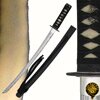 |
|
| Hanwei Gorin Iaito Wakizashi (SH5020) |
Points: 20


|
Iaito have long been the preferred training tools for safe practice of the many Japanese sword drawing arts typically known as Iaido. While not designed for sword-on-sword contact or actual test cutting, the un-edged iaito is perfectly weighted and balanced for its designed task of safe, repetitive drawing practice.
The Nami, Gorin, and Tsuru iaito are a breakthrough in design and functionality. Made of a special stainless steel, the blades are much more durable than iaito blades made from aluminum alloy, with a "live" feel and much superior rigidity. Through a special tempering process, these Iaito blades eliminate the brittle behaviour sometimes associated with stainless steel, while retaining its low maintenance and rust-resistant qualities. These very affordable Iaito are the ideal training tools for safely praciticing this ancient art.
White Same w/ Matte Leather Ito, Black Cotton Sageo
Musashi Tsuba, Brushed Fuchi & Kashira
Silver Menuki, Habaki, Seppa, Shitodome
Sold Out
|
|
|
|
|
|
|
|
Tags:
swords, sword, katana, wakizashi, tanto, japanese sword, medieval sword, viking sword, japanese swords, medieval swords, viking swords, knife, knives, saber, armour, movie swords, movie replicas, martial arts, sporting goods, sporting equipment,
|
















